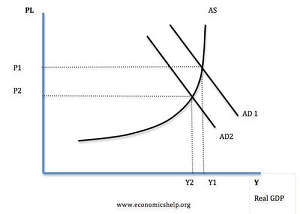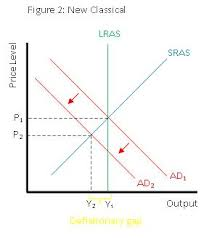
Macroeconomics is a branch of economics that focuses on the trends and movements in the economy as a whole. Macroeconomics factors always influence each other like the aggregate level of employment in the economy, inflation levels, national income, gross domestic product, consumer price index, and the rate of economic growth among others. Microeconomics, on the other hand, deals with individual and business decisions.
Economics theory is a wide concept that explains the movements of cycles in an economy backed with scientific evidence, which proves their hypothesis. Economists have interests in economic theories to devise ways for managing the economy. A number of economic theories focus on the various aspects of economics in managing the macroeconomic aspects. Classical macroeconomics theories are aligned with free market systems where there is little intervention by the economists to manage economic situations in an economy (Parkin, et. al 20).
Gross domestic product (GDP) is the total market value of all goods and services produced within the borders of a country. It is equivalent to exports minus imports then adding public and private consumption and gross investment by the public and private sector. The growth of GDP is influenced by the economic cycles, when the economy contracts the GDP rate reduces and when it expands the GDP grows. For example the GDP of the US has been growing at an annual rate of 4%. The expansion of the GDP can keep expanding as long as the economic conditions are favorable.
The modern economic concepts use Keynesian economic theories that dictate the anticipated interventions by economists to manage the various economic cycles. For instance, during periods of economic recession economic performance slows and many of the indicators are usually negative. However, such conditions do not last forever as they die because of unpredictable shocks.
Economists use a number of measures to manage economic cycles. To encourage a sustained expansion of the economy, economists put structures that control the monetization of the economy and the business environment. Measures to sustain economic expansion include inflation, which is the sustained increases in the general price level of goods and services in an economy. It increases the cost of living for citizens of a country because they are not able to purchase goods and services with the money they had in the recent past.
Inflation, therefore, reduces the welfare and wellbeing of the population because it reduces their real income. It as well leads to decreases in savings that are significant for investment, increased cost of production and high commodity prices. The US has maintained its inflation level at 2%, which is good for economic growth. This rate has given the US economy good room for economic expansion with the economy expected to continue expanding up to 2018 (Macro Economics 2006). This situation is explained by the Long Run Aggregate Supply (LRAS) (appendix 2) through the relationship between the real output and the price levels at full employment.
The LRAS is vertical because firms adjust their costs as price increases. At this point, there is no incentive to produce more in the short run. Therefore, the amount of output that can be produced in the economy is portrayed by the Long Run Aggregate Supply (LRAS) , which is determined by the amount of money in the economy, the amount of labor supplied at full employment, and the available technology (Lavoie et. al 20).
Unemployment is a situation where citizens of employment age are not able to secure a job despite their wish to have a full time job. Unemployment is influenced by the economic cycles like the demand deficient unemployment due to economic contraction. Because of insufficient aggregate demand by the economy, firms tend to cut down on their output meaning that they will employ fewer workers. However, when the economy expands this situation is reversed as employment moves towards its natural level.
Between y2 and y1 (appendix 1) the US economy is at full or natural unemployment at 5%. When aggregate demand shifts to y2, there is positive cyclic unemployment and when aggregate demand shifts towards y1, there is negative unemployment. When the aggregate output is above the natural rate (y1) the short run aggregate supply shifts to the left. When the aggregate output is below the natural rate at (y2), the short run aggregate supply shifts to the right (Kar’ne et. al 56).
The continued expansion of the US economy depends on a number of factors. The prevailing interest rates that are at zero percent and the low inflation rate may give the fed little power to influence the performance of the economy through macroeconomic policies. Macroeconomic policies are the regulations and rules used by economists to stimulate the aggregate economic indicators in an economy. Aggregate economic indicators include the national income, money supply in the economy, inflation, growth rates, unemployment rate, and interest rates among others. Macroeconomic policies use the fiscal and monetary policies to achieve the macroeconomic goals. The fiscal policy entails the change in spending by the government and taxes to stimulate growth. Monetary policy deals with the supply of money in an economy and the parameters that influence money supply in an economy (Dave 45).
Works Cited
Dave, R K. Macro Economic Problems. Jaipur, India: Book Enclave, 2008. Internet resource.
Kar?ne, Manisha, and Vibhuti Patel. The Macro Economic Policies and the Millennium Development Goals. New Delhi: Gyan Pub. House, 2007. Internet resource.
Lavoie, M, Louis-Philippe Rochon, and Mario Seccareccia. Money and Macrodynamics: Alfred Eichner and Post-Keynesian Economics. Armonk, N.Y: M.E. Sharpe, 2010. Internet resource.
Macro Economics. Pearson Education UK, 2006. Internet resource.
Parkin, Michael, Melanie Powell, and K G. P. Matthews. Economics. Harlow: Addison-Wesley, 2000. Print.
Appendices
Appendix 1. Figure 1 Aggregate Demand and Unemployment Curve

Appendix 2. Keynesian Theory Curve

|
Grammar
C
|
Formatting
D
|
Organization
C
|
Style
C
|
